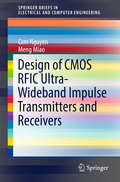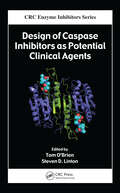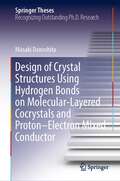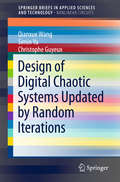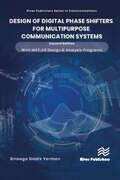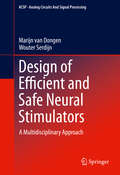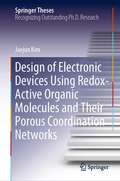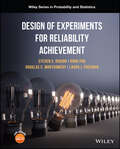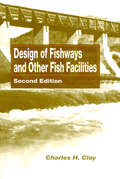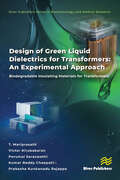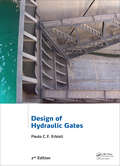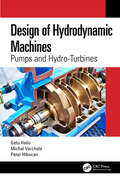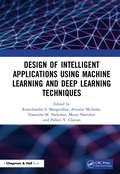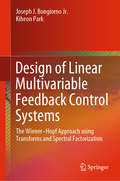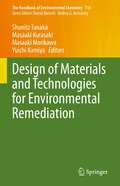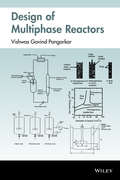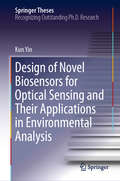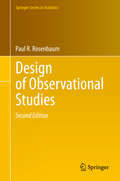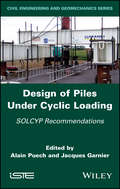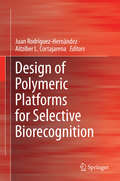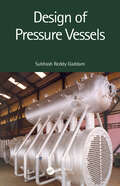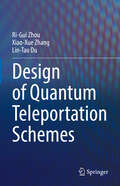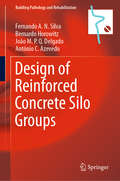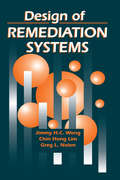- Table View
- List View
Design of CMOS RFIC Ultra-Wideband Impulse Transmitters and Receivers
by Cam Nguyen Meng MiaoThis book presents the design of ultra-wideband (UWB) impulse-based transmitter and receiver frontends, operating within the 3. 1-10. 6 GHz frequency band, using CMOS radio-frequency integrated-circuits (RFICs). CMOS RFICs are small, cheap, low power devices, better suited for direct integration with digital ICs as compared to those using III-V compound semiconductor devices. CMOS RFICs are thus very attractive for RF systems and, in fact, the principal choice for commercial wireless markets. The book comprises seven chapters. The first chapter gives an introduction to UWB technology and outlines its suitability for high resolution sensing and high-rate, short-range ad-hoc networking and communications. The second chapter provides the basics of CMOS RFICs needed for the design of the UWB RFIC transmitter and receiver presented in this book. It includes the design fundamentals, lumped and distributed elements for RFIC, layout, post-layout simulation, and measurement. The third chapter discusses the basics of UWB systems including UWB advantages and applications, signals, basic modulations, transmitter and receiver frontends, and antennas. The fourth chapter addresses the design of UWB transmitters including an overview of basic components, design of pulse generator, BPSK modulator design, and design of a UWB tunable transmitter. Chapter 5 presents the design of UWB receivers including the design of UWB low-noise amplifiers, correlators, and a UWB 1 receiver. Chapter 6 covers the design of a UWB uniplanar antenna. Finally, a summary and conclusion is given in Chapter 7.
Design of Caspase Inhibitors as Potential Clinical Agents
by Tom O’Brien Steven D. LintonPresents the Therapeutic Potential for Caspase Inhibitors: Present and FutureCaspases represent one of the most specific protease families described to date. These extremely important enzymes are crucial to the destruction of aberrant cells - the body's self-protection mechanism for warding off the growth of abnormal cells, many of which can promot
Design of Crystal Structures Using Hydrogen Bonds on Molecular-Layered Cocrystals and Proton–Electron Mixed Conductor (Springer Theses)
by Masaki DonoshitaThis thesis addresses the design of crystal structures using hydrogen bonds. In particular, it focuses on the design of functionalities and the control over the packing of molecular assemblies, based on molecular designs.Firstly, the synthesis and evaluation of a proton–electron mixed conducting charge transfer salt is reported. Focusing on the difference in the strength of hydrogen bonds and weaker intermolecular interactions, a system was rationally designed and constructed where electron-conducting molecular wires were encapsulated within a proton-conducting matrix. Next, the investigation of structural phase transitions in a cocrystal consisting of hydrogen-bonded two-dimensional molecular assemblies is reported. Drastic rearrangements of hydrogen-bonded molecular assemblies in the cocrystal led to single-crystal-to-single-crystal phase transitions, resulting in anisotropic changes in the crystal shape. Furthermore, chemical modification of a component molecule in the cocrystal is reported. The modification afforded control over the stacking patterns of the two-dimensional molecular assemblies, i.e., sheets, and the mechanism was discussed considering the intersheet intermolecular interactions and molecular motion.It is suggested that hydrogen bonds are beneficial to construct molecular assemblies in molecular crystals because of their strength and well-defined directionality, and the consideration of coexisting weaker intermolecular interactions can lead to the design of whole crystal structures and, hence, functionalities. This thesis benefits students and researchers working on solid-state chemistry by presenting various methods for characterizing and evaluating the properties of molecular solids.
Design of Digital Chaotic Systems Updated by Random Iterations (SpringerBriefs in Applied Sciences and Technology)
by Qianxue Wang Simin Yu Christophe GuyeuxThis brief studies the general problem of constructing digital chaotic systems in devices with finite precision from low-dimensional to high-dimensional settings, and establishes a general framework for composing them. The contributors demonstrate that the associated state networks of digital chaotic systems are strongly connected. They then further prove that digital chaotic systems satisfy Devaney’s definition of chaos on the domain of finite precision. The book presents Lyapunov exponents, as well as implementations to show the potential application of digital chaotic systems in the real world; the authors also discuss the basic advantages and practical benefits of this approach. The authors explore the solutions to dynamic degradation (including short cycle length, decayed distribution and low linear complexity) by proposing novel modelling methods and hardware designs for two different one-dimensional chaotic systems, which satisfy Devaney’s definition of chaos. They then extend it to a higher-dimensional digital-domain chaotic system, which has been used in image-encryption technology. This ensures readers do not encounter large differences between actual and theoretical chaotic orbits through small errors. Digital Chaotic Systems serves as an up-to-date reference on an important research topic for researchers and students in control science and engineering, computing, mathematics and other related fields of study.
Design of Digital Phase Shifters for Multipurpose Communication Systems
by Binboga Siddik YarmanThis book aims to cover a new emerging need in designing digital phase shifter for modern communication systems. With the advancement of new generation mobile communication systems, directed beams of antenna arrays save a substantial amount of power as well as improve the communication quality. In this regard, beam-forming circuits, such as digital phase shifters (DPS) constitute essential parts of the antenna array systems. Therefore, this book is devoted to the design of digital phase shifters for various communications systems. Nowadays, phase array systems demand compact phase shifters suitable for chip implementation with wide phase-range and broad frequency band. Each chapter of this book is organized as stand-alone in such a way that the reader requires no specific background acquired from the other chapters. For each phase shifter topology introduced in this book, the reader is furnished with explicit design equations to construct the circuit under consideration. Furthermore, design equations are programmed using MATLAB to assess the electrical performance of the phase shifters with ideal and lossy components. MATLAB design programs are given at the and of each chapter as appendices and provided as soft copy on the web page of the book. In chapters 12 and 14, MMIC layouts for the lattice and T-section based DPS are provided for the readers. It is hoped that an interested reader can immediately identifies the “optimum phase shifter topology” for the need under consideration with its estimated electric performance.
Design of Efficient and Safe Neural Stimulators
by Marijn Van Dongen Wouter SerdijnThis book discusses the design of neural stimulator systems which are used for the treatment of a wide variety of brain disorders such as Parkinson's, depression and tinnitus. Whereas many existing books treating neural stimulation focus on one particular design aspect, such as the electrical design of the stimulator, this book uses a multidisciplinary approach: by combining the fields of neuroscience, electrophysiology and electrical engineering a thorough understanding of the complete neural stimulation chain is created (from the stimulation IC down to the neural cell). This multidisciplinary approach enables readers to gain new insights into stimulator design, while context is provided by presenting innovative design examples.
Design of Electronic Devices Using Redox-Active Organic Molecules and Their Porous Coordination Networks (Springer Theses)
by Jaejun KimThis book addresses the development of electronic devices using redox-active organic molecules and their porous coordination networks (PCNs), and highlights the importance of the molecular arrangement. Redox-active organic molecules hold considerable promise as flexible electronic elements, because their electronic state can easily be controlled using external energy. Although various kinds of redox-active organic molecules have been synthesized, attempts to apply them to electronic devices have been limited, owing to the lack of proper structural design. Moreover, ligand-based redox-active PCNs remain largely unexplored because of the limited availability of redox-active ligands. In addition to developing new redox-active organic molecules, in order to design electronic devices based on these molecules/PCNs, it is essential to understand the connections between their molecular arrangement, electrical properties, and redox activity. In this thesis, the redox-active organic molecule 2,5,8-tri(4-pyridyl)1,3-diazaphenalene (TPDAP), which features a large pi plane and multi-intermolecular interactivity, is used to develop a resistive switching memory device. In addition, its PCNs are synthesized to fabricate chemiresistive sensors, and the electrical properties are modulated using post-synthetic modification. Each mechanism is systematically investigated by means of structural determination and well-defined control experiments. Subsequently, the book proposes general guidelines for designing electronic devices using redox-active organic molecules. The book will appeal to a broad range of readers, from basic scientists to materials engineers, as well as general, non-expert readers.
Design of Experiments for Reliability Achievement (Wiley Series in Probability and Statistics)
by Douglas C. Montgomery Steven E. Rigdon Rong Pan Connie M. BorrorENABLES READERS TO UNDERSTAND THE METHODS OF EXPERIMENTAL DESIGN TO SUCCESSFULLY CONDUCT LIFE TESTING TO IMPROVE PRODUCT RELIABILITY This book illustrates how experimental design and life testing can be used to understand product reliability in order to enable reliability improvements. The book is divided into four sections. The first section focuses on statistical distributions and methods for modeling reliability data. The second section provides an overview of design of experiments including response surface methodology and optimal designs. The third section describes regression models for reliability analysis focused on lifetime data. This section provides the methods for how data collected in a designed experiment can be properly analyzed. The final section of the book pulls together all of the prior sections with customized experiments that are uniquely suited for reliability testing. Throughout the text, there is a focus on reliability applications and methods. It addresses both optimal and robust design with censored data. To aid in reader comprehension, examples and case studies are included throughout the text to illustrate the key factors in designing experiments and emphasize how experiments involving life testing are inherently different. The book provides numerous state-of-the-art exercises and solutions to help readers better understand the real-world applications of experimental design and reliability. The authors utilize R and JMP® software throughout as appropriate, and a supplemental website contains the related data sets. Written by internationally known experts in the fields of experimental design methodology and reliability data analysis, sample topics covered in the book include: An introduction to reliability, lifetime distributions, censoring, and inference for parameter of lifetime distributions Design of experiments, optimal design, and robust design Lifetime regression, parametric regression models, and the Cox Proportional Hazard Model Design strategies for reliability achievement Accelerated testing, models for acceleration, and design of experiments for accelerated testing The text features an accessible approach to reliability for readers with various levels of technical expertise. This book is a key reference for statistical researchers, reliability engineers, quality engineers, and professionals in applied statistics and engineering. It is a comprehensive textbook for upper-undergraduate and graduate-level courses in statistics and engineering.
Design of Experiments: Statistical Principles of Research Design and Analysis (2nd Edition)
by Robert O. KuehlThis edition prepares students to design and analyze experiments that will help them succeed in the real world. The author uses a large array of real data sets from a broad spectrum of scientific and technological fields. He emphasizes the importance of developing a treatment design based on a research hypothesis as an initial step, then developing an experimental or observational study design that facilitates efficient data collection.
Design of Fishways and Other Fish Facilities
by Charles H. ClayThis new edition of the best-selling book describes the main types of fishways and fish facilities used around the world to assist the passage of fish over dams and other obstructions to their migration. It also focuses on the protection of fish (mainly young fish) from the hazards encountered in their downstream migrations. The book brings together the type of knowledge and research needed to decide on the facility used as well as its design and operation. It emphasizes the need for both biologists and engineers to collaborate in the design and indicates in what fields such collaboration would benefit fisheries conservation in the future. This is the Second Edition of the only book to bring together all of these topics worldwide under one cover.
Design of Green Liquid Dielectrics for Transformers: Biodegradable Insulating Materials for Transformers (River Publishers Series in Biotechnology and Medical Research)
by T. Mariprasath Victor Kirubakaran Perumal Saraswathi Reddy Kumar Cheepati Prakasha Kunkanadu RajappaThis book provides in-depth information about the latest trends in transformer insulation design. This practical guide is prepared from a hands-on perspective, offering readers valuable insights into the trends in liquid dielectrics for transformer applications. Chapter 1 covers the necessity of alternate liquid dielectrics for transformers. Chapter 2 delves into the historical development of liquid dielectrics for transformer applications, drawing insights from reputable publications. It also explores the impact of nanoparticles on ester oil characteristics. In Chapter 3, the significance of spectroscopy analysis for investigating the ageing effect on both cellulosic insulating materials and oil samples is discussed. Chapter 4 describes material preparations followed by experimental analysis, estimating the degradation rate of solid and liquid dielectrics using spectroscopies. Chapter 5 discusses the importance of condition monitoring for transformers and its historical methods. Chapter 6 explores the methodology for hot spot indication and its application for assessing the transformer's condition. It covers real-time case studies as well. In Chapter 7, the book investigates the application of artificial intelligence in transformer insulation systems, leveraging machine learning algorithms to predict transformer insulation.
Design of Hydraulic Gates
by Paulo C.F. ErbistiRevised and updated, this second edition of Design of Hydraulic Gates maintains the same goal as the original: to be used as a textbook and a manual of design of gates, presenting the main aspects of design, manufacture, installation and operation of hydraulic gates, while introducing new products, technologies and calculation procedures. This edit
Design of Hydrodynamic Machines: Pumps and Hydro-Turbines
by Getu Hailu Michal Varchola Peter HlbocanDesign of Hydrodynamic Machines provides a broad, yet concise, theoretical background on the relationship between fluid dynamics and geometry. It covers the most important types of turbomachinery used in power generation industrial processes, utilities, and the oil and gas industry. Offering guidance on the hydraulic design aspect of different parts of turbomachinery, such as impellers, diffusers, volute casing, inlet and outlets, the book discusses how to conduct performance characteristics testing and evaluate performance parameters of the designed parts. It also covers aspects of CFD of turbomachinery. Readers will be able to perform hydraulic design of important turbomachinery parts using commercially available software.Intended for final year undergraduates and postgraduates in mechanical, civil, and aeronautical engineering, the book will also be useful for those involved in the hydraulic design, analysis, and testing of turbomachinery.
Design of Intelligent Applications using Machine Learning and Deep Learning Techniques
by Antonis Michalas Meera Narvekar Ramchandra S. Mangrulkar Narendra M. Shekokar Pallavi V. ChavanMachine learning (ML) and deep learning (DL) algorithms are invaluable resources for Industry 4.0 and allied areas and are considered as the future of computing. A subfield called neural networks, to recognize and understand patterns in data, helps a machine carry out tasks in a manner similar to humans. The intelligent models developed using ML and DL are effectively designed and are fully investigated – bringing in practical applications in many fields such as health care, agriculture and security. These algorithms can only be successfully applied in the context of data computing and analysis. Today, ML and DL have created conditions for potential developments in detection and prediction. Apart from these domains, ML and DL are found useful in analysing the social behaviour of humans. With the advancements in the amount and type of data available for use, it became necessary to build a means to process the data and that is where deep neural networks prove their importance. These networks are capable of handling a large amount of data in such fields as finance and images. This book also exploits key applications in Industry 4.0 including: · Fundamental models, issues and challenges in ML and DL. · Comprehensive analyses and probabilistic approaches for ML and DL. · Various applications in healthcare predictions such as mental health, cancer, thyroid disease, lifestyle disease and cardiac arrhythmia. · Industry 4.0 applications such as facial recognition, feather classification, water stress prediction, deforestation control, tourism and social networking. · Security aspects of Industry 4.0 applications suggest remedial actions against possible attacks and prediction of associated risks. - Information is presented in an accessible way for students, researchers and scientists, business innovators and entrepreneurs, sustainable assessment and management professionals. This book equips readers with a knowledge of data analytics, ML and DL techniques for applications defined under the umbrella of Industry 4.0. This book offers comprehensive coverage, promising ideas and outstanding research contributions, supporting further development of ML and DL approaches by applying intelligence in various applications.
Design of Linear Multivariable Feedback Control Systems: The Wiener–Hopf Approach using Transforms and Spectral Factorization
by Kiheon Park Joseph J. Bongiorno Jr.This book contains a derivation of the subset of stabilizing controllers for analog and digital linear time-invariant multivariable feedback control systems that insure stable system errors and stable controller outputs for persistent deterministic reference inputs that are trackable and for persistent deterministic disturbance inputs that are rejectable. For this subset of stabilizing controllers, the Wiener-Hopf methodology is then employed to obtain the optimal controller for which a quadratic performance measure is minimized. This is done for the completely general standard configuration and methods that enable the trading off of optimality for an improved stability margin and/or reduced sensitivity to plant model uncertainty are described. New and novel results on the optimal design of decoupled (non-interacting) systems are also presented. The results are applied in two examples: the one- and three-degree-of-freedom configurations. These demonstrate that the standard configuration is one encompassing all possible feedback configurations. Each chapter is completed by a group of worked examples, which reveal additional insights and extensions of the theory presented in the chapter. Three of the examples illustrate the application of the theory to two physical cases: the depth and pitch control of a submarine and the control of a Rosenbrock process. In the latter case, designs with and without decoupling are compared. This book provides researchers and graduate students working in feedback control with a valuable reference for Wiener–Hopf theory of multivariable design. Basic knowledge of linear systems and matrix theory is required.
Design of Materials and Technologies for Environmental Remediation (The Handbook of Environmental Chemistry #115)
by Shunitz Tanaka Masaaki Kurasaki Masaaki Morikawa Yuichi KamiyaThis book describes environmental remediation technologies to remove pollutants from the environment and the environmental materials used for remediation. The focus is on the functional design of environmental materials, especially to create materials for coping with a variety of pollutants in different concentrations and conditions. The authors present research highlights from their work in this area and aim to inspire the development of new concepts in environmental remediation. This work is a must-read for practitioners who are exploring restoration technologies and materials for solving environmental pollution as well as researchers and graduate students studying environmental remediation. A number of Asian researchers who have been engaged in these studies are among the authors, and this book will contribute to solving pollution problems in Asia as well as the rest of the world.
Design of Multiphase Reactors
by Vishwas G. PangarkarDetails simple design methods for multiphase reactors in the chemical process industriesIncludes basic aspects of transport in multiphase reactors and the importance of relatively reliable and simple procedures for predicting mass transfer parametersDetails of design and scale up aspects of several important types of multiphase reactorsExamples illustrated through design methodologies presenting different reactors for reactions that are industrially importantIncludes simple spreadsheet packages rather than complex algorithms / programs or computational aid
Design of Novel Biosensors for Optical Sensing and Their Applications in Environmental Analysis (Springer Theses)
by Kun YinThis book introduces readers to the development of novel optical biosensors for environmental analysis. Environmental pollution has now become a serious problem, which threatens the health of human beings. Traditional analytical methods have a number of drawbacks, such as the need for professional operators and complicated instruments. After millions of years of evolution, biomolecules can perform various functions with good accuracy and efficiency due to their unique structures, offering a viable alternative to traditional methods. This work focuses on using new biological sensing strategies, e.g. those based on special biomaterials, bio-reactions or living cells, to establish novel biosensors. As these biosensors offer satisfactory optical response performance, they can be used to transform the recognition behavior of specific targets into optical signals and effectively detect target objects.
Design of Observational Studies (Springer Series in Statistics)
by Paul R. RosenbaumThis second edition of Design of Observational Studies is both an introduction to statistical inference in observational studies and a detailed discussion of the principles that guide the design of observational studies. An observational study is an empiric investigation of effects caused by treatments when randomized experimentation is unethical or infeasible. Observational studies are common in most fields that study the effects of treatments on people, including medicine, economics, epidemiology, education, psychology, political science and sociology. The quality and strength of evidence provided by an observational study is determined largely by its design. Design of Observational Studies is organized into five parts. Chapters 2, 3, and 5 of Part I cover concisely many of the ideas discussed in Rosenbaum’s Observational Studies (also published by Springer) but in a less technical fashion. Part II discusses the practical aspects of using propensity scores and other tools to create a matched comparison that balances many covariates, and includes an updated chapter on matching in R. In Part III, the concept of design sensitivity is used to appraise the relative ability of competing designs to distinguish treatment effects from biases due to unmeasured covariates. Part IV is new to this edition; it discusses evidence factors and the computerized construction of more than one comparison group. Part V discusses planning the analysis of an observational study, with particular reference to Sir Ronald Fisher’s striking advice for observational studies: "make your theories elaborate." This new edition features updated exploration of causal influence, with four new chapters, a new R package DOS2 designed as a companion for the book, and discussion of several of the latest matching packages for R. In particular, DOS2 allows readers to reproduce many analyses from Design of Observational Studies.
Design of Piles Under Cyclic Loading: SOLCYP Recommendations
by Alain Puech Jacques GarnierRecent developments in the fields of energy, transport and industrial engineering have led to the emergence of new types of structures and infrastructures subject to variable stresses, for which the usual methods for designing pile foundations are now inadequate. The recommendations presented in this book will help to partly fill this technical gap by proposing a methodological approach and calculation methods to take account of the effects of cyclic loads in the design of foundations on piles. These are based on both laboratory and full scale experiments, and on modeling carried out within the framework of the national SOLCYP project.
Design of Polymeric Platforms for Selective Biorecognition
by Juan Rodríguez-Hernández Aitziber L. CortajarenaThis book addresses in an integrated manner all the critical aspects for building the next generation of biorecognition platforms - from biomolecular recognition to surface fabrication. The most recent strategies reported to create surface nano and micropatterns are thoroughly analyzed. This book contains descriptions of the types of molecules immobilized at surfaces that can be used for specific biorecognition, how to immobilize them, and how to control their arrangement and functionality at the surface. Small molecules, peptides, proteins and oligonucleotides are at the core of the biorecognition processes and will constitute a special part of this book. The authors include detailed information on biological processes, biomolecular screening, biosensing, diagnostic and detection devices, tissue engineering, development of biocompatible materials and biomedical devices.
Design of Pressure Vessels
by Subhash Reddy GaddamPressure vessels are prone to explosion while in operation, due to possible errors in material selection, design and other engineering activities. Addressing issues at hand for a working professional, this book covers material selection, testing and design of pressure vessels which enables users to effectively use code rules and available design softwares. Relevant equation derivations have been simplified with comparison to ASME codes. Analysis of special components flange, bellow and tube sheet are included with their background. Topics on tube bend, supports, thermal stresses, piping flexibility and non-pressure parts are described from structural perspective. Vibration of pressure equipment components are covered as well.
Design of Quantum Teleportation Schemes
by Ri-Gui Zhou Xiao-Xue Zhang Lin-Tao DuThis book offers a design-centered approach to quantum teleportation as well as in-depth analysis of various quantum teleportation schemes. Quantum teleportation, a vital component of practical quantum communication technologies, serves as a secure and reliable way to transmit confidential information. Quantum teleportation relies on the unique physical property of quantum superposition, accomplishing the remote transmission of information through unitary transformations and measurements on entangled states, combined with classical communication. Therefore, as one of the safe and reliable means of quantum state transmission between communicating parties, quantum teleportation is bound to play a vital role in future quantum communication. This book begins with the basics of quantum teleportation before going on to consider various refinements such as controlled, bidirectional, cyclic, symmetric, and asymmetric scenarios. It goes further, investigating a multitude of quantum teleportation schemes in bidirectional, controlled bidirectional, cyclic bidirectional, asymmetric cyclic controlled, and noisy environments, and conducts detailed performance analyses of these schemes. This book is an essential resource for students, researchers, and professionals in the field of quantum communications.
Design of Reinforced Concrete Silo Groups (Building Pathology and Rehabilitation #10)
by António C. Azevedo Fernando A.N. Silva Bernardo Horowitz João M.P.Q. DelgadoThis book offers a new calculation procedure of the structural behavior of grouped layout of silos, easy to use and with satisfactory responses. Groups of reinforced concrete silos are structures commonly used in the food industry, where it is usually necessary to separate the storage of different types and sources of grain. The grouped layout of silos has numerous benefits when compared with single-cell silos in which the emphasis is on creating further space for silage, normally referred to as interstice – a space formed between the edges of the group’s cells. This economic benefit, on the other hand, raises a structural problem for the designer of this type of building, which is to assess the magnitude of bending moments and hoop forces due to the structural continuity of the walls in the interstice region of the cells. Bending moments assume extreme values exactly when the interstice is loaded and the other cells in the group are empty. To develop the formulation of the proposed analysis models, a parametric study was carried out that allowed the adequate consideration of the variables involved. The idea is to help professionals, engineers, industrials and academics involved in this advanced interdisciplinary field as a comprehensive guide for courses offered at different levels of learning (undergraduate and postgraduate).
Design of Remediation Systems
by Jimmy H. Wong Chin Hong Lim Greg L. NolenWhile numerous books are available on remediation systems, this is the first work to document and explain in full the design aspects of the subject. Based on sound engineering principles and practical construction considerations, this text explains the entire process of remediation design, from assessment to completion, and provides engineers with the tools they need to conduct a pilot test, apply the results, and design a practical, efficient system.Design of Remediation Systems first establishes the underlying principles behind each technology, then outlines the standard procedures for designing a system. This comprehensive manual explains feasibility and pilot tests, data evaluation, design considerations and parameters, calculations and equations, and construction aspects of the system. Also featured are discussions of the operation and maintenance of systems, and analysis of current trends, such as combining soil vapor extraction with air sparging. Detailed case study examples are included in each chapter. The book considers petroleum hydrocarbons as the primary contaminant, but the principles and procedures can be applied to a wide range of other contaminants.This hands-on text/reference presents a complete picture of remediation system design for engineers, students, and scientists. No other single work offers the thorough coverage of this critical aspect of remediation.
